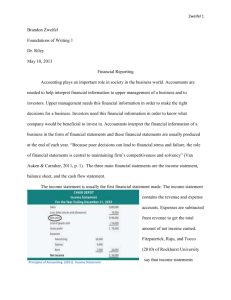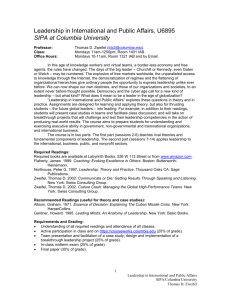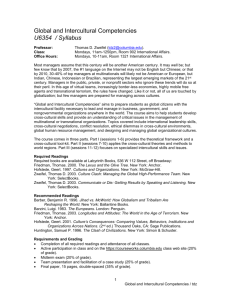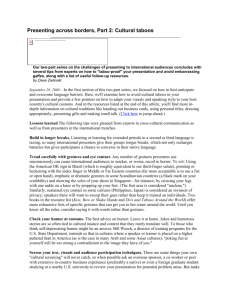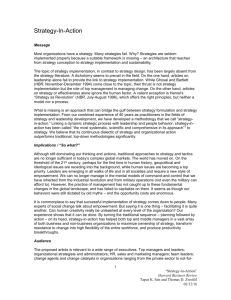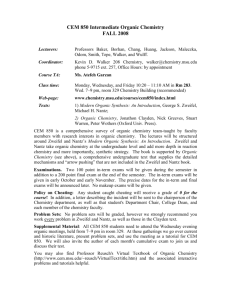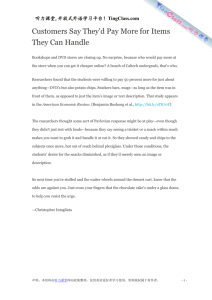global marketing coursework – the case of Zweifel Chips AG
advertisement
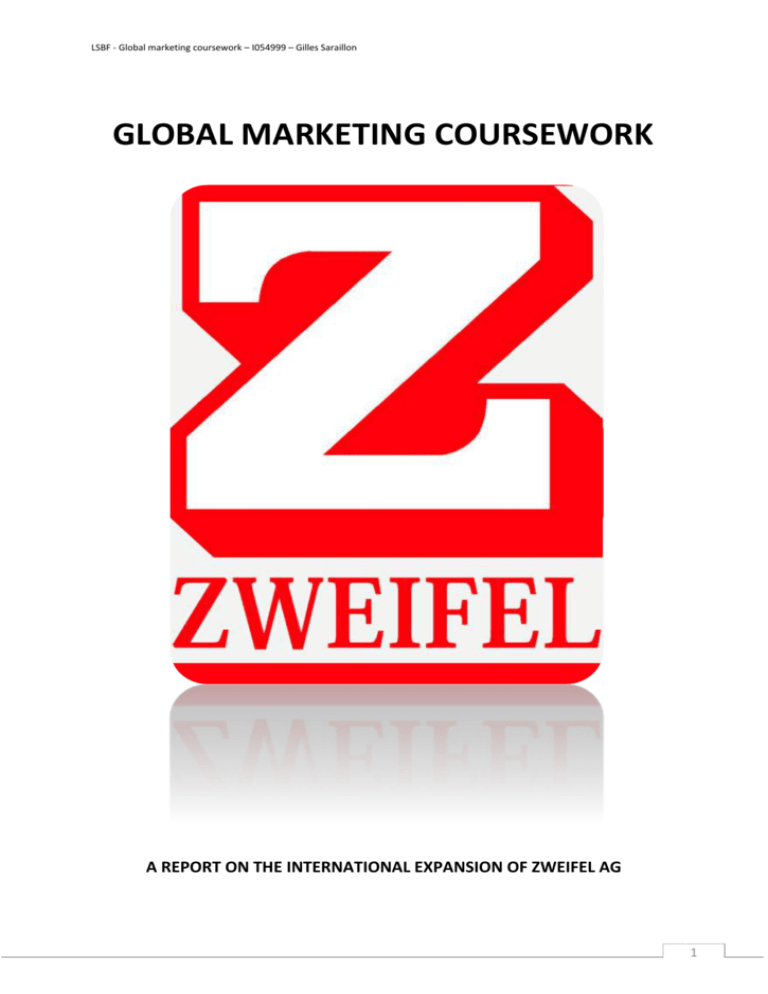
LSBF - Global marketing coursework – I054999 – Gilles Saraillon GLOBAL MARKETING COURSEWORK A REPORT ON THE INTERNATIONAL EXPANSION OF ZWEIFEL AG 1 LSBF - Global marketing coursework – I054999 – Gilles Saraillon TABLE OF CONTENTS 1. COMPANY OVERVIEW 2. MARKET & CONSUMERS OVERVIEW 3. MOTIVES FOR INTERNATIONALIZATION 4. ENVIRONMENT ANALYSIS 5. COMPANY OBJECTIVES 6. ENTRY STRATEGY AND MARKETING STRATEGY 7. CONCLUSION 8. BIBLIOGRAPHY AND REFERENCES 2 LSBF - Global marketing coursework – I054999 – Gilles Saraillon 1. COMPANY OVERVIEW (zweifel.ch)1 Company summary Zweifel AG is a swiss company active in the production of potato chips. It was founded in 1950 in Katzenrüti, near Zürich by Hans Meier. This family-owned business first started to produce crisps in an artisanal, manual fashion. In 1956, Zweifel imported a production line system from the USA to standardize and increase their production. They also produced cider until 1983, before selling the business to focus exclusively on snacks. Today Zweifel is a household name in Switzerland and the clear market leader in its industry. Products range Standard potato chips Zweifel currently produce 6 different types of original chips (paprika, curry, original, salt & vinegar, provençal, red & hot). This product range is also declined under a reduced fat sub-brand (Cractiv). Higher segment chips More expensive than the regular line and sporting a more refined packaging, these crisps focus on quality and taste sophistication. Switzerland being heavily influence by Italian cuisine, Zweifel introduced the new Merranea line that draws on Mediterranean flavors (olive, basil, oregano, etc..). The ‘Secrets’ product range caters to more adventurous consumers looking for mysterious tastes, as the sub-brand name suggest. Currently, they have Red & Black pepper, African spices and Dijon mustard flavored chips. 3 LSBF - Global marketing coursework – I054999 – Gilles Saraillon Graneo appeals to heatlh-conscious individuals through multi-cereal ingredients and organiclooking packaging. Other products Aside from their main line, other products complement Zweifel’s portfolio. Snacketti have different shapes to make them ‘fun’ to eat and are designed to be consumed during ‘apéritifs’ (casual bar or family meetings happening prior to lunch or dinner, usually comprised of finger foods such as dry snacks, accompanied with wine). Pop Corn and Joujoux appeal to younger consumers. Joujoux chips include a toy in the package. Corn Chips aren’t potato-based per se, but I believe Zweifel also want to occupy the ‘Mexican’ snack segment with these chips and the accompanying dipping sauces. Poppit’s is a relatively new addition to Zweifel’s portfolio. Before Pringles was available in Switzerland, no tubular packaging was produced by Zweifel. Besides, regular Zweifel’s chips aren’t reconstituted, tile-shaped chips but come in various sizes and shapes, depending on the raw materials used at the time of production. This move was obviously made to compete directly with Pringles as there really wasn’t any other incentive for Zweifel to do so on their own, considering swiss consumer habits and probably preference for chips that aren’t reprocessed and reshaped like Pringles’. Facts & figures Figure 1.1 – Zweifel’s Aisle Dominance Zweifel has an annual turnover of CHF 190 Mios and a market share of 50%, their dominance on the swiss market is well illustrated by figure 1.1: the whole potato chips aisle at a popular gas station contains only Zweifel products. The company employs more than 400 people and sources its raw materials exclusively in Switzerland. About 400 farms supply 4 LSBF - Global marketing coursework – I054999 – Gilles Saraillon Zweifel 22,000 tons of potatoes per year, with a final output of 6,600 tons of finished product. 2. MARKET AND CONSUMERS OVERVIEW Right now, Zweifel focuses on the swiss market, with timid forays into France and Germany. Their dominant position in Switzerland, the lack of long term growth prospects locally and the quality of their products could all contribute to an internationalization of the company. This report will attempt to identify and justify the risks and opportunities Zweifel could experience when deciding to expand abroad. Switzerland is a very small country and with only 7,6 million people and a projected population growth rate of 0,21% (indexmundi.com)2, it is quite obvious that Zweifel long term growth resides elsewhere. Consumers Primary and secondary data regarding Zweifel’s consumer base is unavailable or dated so it was chosen to rely on personal experience, observations and empirical findings in attempting to define Zweifel markets in Switzerland. Due to its very large market share, large distribution and a pool of sales representatives that tour businesses, bars and restaurants (generating 2,000 contacts and 24,000 sales per day)1, Zweifel has the ability to cater to consumers involved in any type of activity and among all demographics, thanks to its wide portfolio. Whether it’s impulse purchases at the gas stations or more common consumption scenarios like in super or hypermarkets, local bars, rural and remote restaurants, Zweifel covers a lot of ground. Therefore, I’d say that the consumer type for them is only limited to their marketing department’s consumer intelligence and data. I detailed the existing products range that have already an appeal for major consumer types and contexts. We’ll later see how Zweifel should adapt their products when they expand internationally. 3. MOTIVES FOR INTERNATIONALIZATION Although making money is the fundamental driver behind a firm’s internationalization, other motives come also into play (Hollensen, 2011)3. In the case of Zweifel, a blend of proactive and reactive motives combined to cause a reflection as to how, when and where to internationalize the company’s products. Hollensen identifies major internationalization motives as follows: Figure 1.2 – Major motives for starting export (Hollensen, 2011) 5 LSBF - Global marketing coursework – I054999 – Gilles Saraillon The attractiveness of the BRIC countries is not necessary to stress again. With a booming population and an ever-rising GDP (worldbank.org)3, these states are becoming major markets that companies can no longer afford to overlook. In the case of Zweifel, I believe that the main proactive motives would be the market opportunities that BRIC countries offer, growth and economies of scale that these countries can provide as well. Reactively, Zweifel’s main issue is that they operate in a very small market that doesn’t seem to offer long term growth opportunities. The company already commands a whopping 50% market share in Switzerland, so it’s difficult to imagine that this share will significantly increase in the coming years. New entrants have surfaced in the swiss potato chips market, namely Pringles and Chio, but they have so far failed to make an impression due to Zweifel dominance in their distribution netwoks, their first-mover advantage and the quasi-cult status their products garnered among consumers. ‘’Brands are reluctant to launch into countries that are culturally and economically less similar to the home market’’ (Nejati, Mehran & Nejati, 2011)4. This makes sense, because psychological distance in one of the main factors that can tip the scales in favor or at the detriment of an internationalization. Of course, Switzerland is culturally and economically quite distinct from any of the BRIC countries, except maybe Brazil due to their latin roots and similar language. We’ve already seen that Zweifel made some forays into France and Germany, where psychic distance is close to non-existent due to the languages spoken there (both French and German are official languages in Switzerland) and the largely identical culture: the northern part of Switzerland shares a border with Germany and shares common values, while the western and south-eastern parts of Switzerland have France for neighbour and predominantly speak French as a mother tongue. So, in a sense, we can’t really consider Zweifel’s presence in France and Germany a true internationalization move, but rather a natural extension of the company’s home activities. 6 LSBF - Global marketing coursework – I054999 – Gilles Saraillon COUNTRY SELECTION Although Brazil, Russia, India and China have a common denominator in the form of high growth and an increase in middle-class population, these countries are geographically, culturally and socially very different. We saw that psychological distance could play a major role in the selection of a country in which to expand, so deriving from this matter of fact, the least artificial and probably least risky choice would be Brazil. Brazil shares consuming habits, culture and language with Switzerland that are less alien than the three other countries. So from a psychological distance point of view, Brazil makes the most sense. Now we should nuance this by examining the attractiveness of the Brazilian snack market compared to Russia, India and China. Unfortunately, primary and even secondary data regarding the potato chips market in the BRIC countries is not readily and freely available so we’ll have to use other methods to base our choice on. The use of theoretical models based on macro-environment findings seems to be the most relevant approach. Do define the attractiveness of the Brazilian market, we can for example use the following matrix: Figure 1.3 – market attractiveness matrix (modified from Hollensen, 2011) 1 very poor Market size Market growth Buying structure Prices Buying power Market access Competitive intensity Political/economical risks TOTAL 2 poor 3 medium 4 good 5 very good X X X X X X X X % weighting Result (grade X weighting) 20 20 5 5 5 10 10 100 100 15 20 15 40 10 10 30 100 330 Weighting is based on the proactive motives discussed earlier, where market size and growth potential was among the most important factors justifying and internationalization of Zweifel’s activities. Given that potato chips are universally affordable, buying structure, prices and buying power were given less weight. However, macro factors like access to the market (mostly defined by the country’s law), competitive rivalry and politico-economic aspects were given more weight because I believe that they could impede Zweifel’s success but not to the same extent as initial market size and growth could if they were rated poorly on this scale. 7 LSBF - Global marketing coursework – I054999 – Gilles Saraillon 4. ENVIRONMENT ANALYSIS BRAZIL PESTEL ANALYSIS Political Factors Brazil is a politically stable country. Former President Lula and current President Rousseff seem to be taking previous problems (corruption) seriously and are trying to tackle them. Institutions and the legal system are modern and up to western standards. Inflation used to be high but this issue has been addressed since Lula took office in 2003, inflation fell from 14% per year to 4%5. Economic Factors With low inflation rates the cost of borrowed capital remains low as well. Foreign firms can fully owned their company there and favorable foreign investment policies add extra incentives for companies looking to set up shop in Brazil6. Societal Factors There are not many ethnic groups in terms of density compared to European countries: more than 50% of the population is white, 40% is of mixed origin (mulatto) and the rest comes from various parts of the world7. Brazil seems like a well-organized and stable society, despite well-known violence problems and extremely unbalanced wealth distribution. Technological Factors Brazil draws most of its economic power from its vast natural resources (wood, fossil energy, precious metals) and its economy is larger than all of its direct neighbours combined. Although not considered an IT-centric nation like India, Brazil has developed its services sector and its IT workforce is highly skilled thanks to adequate educational structures8. Environmental Factors Brazil’s environmental problems are well-publicized: due to its phenomenal growth, Brazil’s needs have swollen as well. Pollution, deforestation and water contamination are some of the issues the government has to find solutions for. Legal Factors As it stands now, I don’t see any legal barrier that could hinder Zweifel’s expansion to Brazil. As said before, the country is trying very hard to attract foreign capital investment and therefore the legal framework should generally be considered favorable for prospective entrants. 8 LSBF - Global marketing coursework – I054999 – Gilles Saraillon PORTER’S 5 FORCES ANALYSIS Bargaining power of suppliers Going international, Zweifel would probably have to deal directly with local farms to source their raw materials. Compared to other incumbents, Zweifel is relatively small and due to their lower volumes, suppliers could economically favor other companies with bigger volumes, hindering in turn Zweifel’s ability to market their products at a competitive price. Bargaining power of buyers With its proprietary network of retails dealers, Zweifel largely controls and limits the power of distributing buyers in Switzerland. In Brazil however, it is likely that this model can’t be duplicated by Zweifel due to the high purchase volumes local distributors have. Therefore, their bargaining power would be much higher than those in Switzerland, reducing Zweifel ability to control their prices. Threat of substitutes As we’ll later see in the market entry section, Brazil has an astonishingly high diversity of brands and companies in the potato chips business. As much as eighteen different companies market their products in Brazil. Potato chips being highly commoditized, substitutes are readily available so this threat is very real for Zweifel. Threat of new entrants The potato chips industry isn’t exactly new and is already quite crowded. It is therefore not probable that new entrants will appear in the near future on the Brazilian landscape. Competitive Rivalry An industry is considered having intense rivalry when products sold in it aren’t very differentiated and commoditized (Ireland et al., 2008)9. Unfortunately for Zweifel, this is exactly the case in the market they’ll compete in. To be viable on the Brazilian market, Zweifel has no choice but to differentiate itself from its competitors. We’ll see how in the marketing strategy section. 5. COMPANY OBJECTIVES SMART objective: Brand Awareness Specific: Raise Zweifel’s brand awareness among all consumers segments through a marketing communications campaign focused on advertising. Measurable: Effectiveness will be measured via consumer polling and market research findings. 9 LSBF - Global marketing coursework – I054999 – Gilles Saraillon Achievable: This objective’s achievability hinges on Zweifel’s airtime purchasing power. Prime time advertising will have a guaranteed impact of brand awareness. Realistic: Raising brand awareness through TV advertising is a very common and effective practice. So it is realistic to think that this goal can be reached. Timed: The longer the better, but Zweifel’s marketing budget is obviously not indefinitely stretchable therefore it is safe to assume that the company can only afford to buy airtime during the first few years of its inception in Brazil. SMART objective: Market Penetration Specific: the immediate natural goal for Zweifel is to capture a share of the market in order to be sustainable. Market penetration is an indirect consequence of the first SMART objective although other marketing communications techniques such as direct marketing and personal selling should be used to ensure healthy sales, because advertising isn’t the most effective marketing communication tool to trigger sales. Measurable: distributor feedback and in-house metrics should be used to assess whether sales goals are met or not. Achievable: again, marketing efforts don’t necessarily provide instant success, especially in such a saturated market, but given the right budget and right people are deployed, gaining traction in Brazil is achievable. Realistic: the market has a lot of players, with a lot of different offerings, but it’s not out of the realm of possibilities to think that Zweifel can capture a few percents of a 200 million people market. Timed: Zweifel should give itself a couple of years before reassessing whether they should stay, modify their strategy or withdraw. 6. ENTRY STRATEGY AND MARKETING STRATEGY A proper, well-defined entry strategy is vital for Zweifel to succeed in Brazil. I believe that the typical export entry mode isn’t the right choice for Zweifel although it might appear as the most straightforward method. Direct export entry strategy Zweifel could choose to tread the easy path by starting to export their products through a buying agent, a middle-man or regular trading company. This way they could get a foot in the Brazilian door without having to commit too many resources (financial, human, capital). The main drawback is the loss of control this method causes. Unless Zweifel takes the time to properly put implementation quality checks in place and have their local staff make frequent 10 LSBF - Global marketing coursework – I054999 – Gilles Saraillon trip to Brazil to oversee the process, it is likely that their potato chips won’t end in the right distributors’ accounts and won’t get the exposure they need. This direct export model dooms Zweifel from the get-go because their products are very typical, very ‘swiss’ so to speak and therefore are differentiated by essence but this unique aspect would go to waste by simply making the product available without a proper positioning and set-up. Our goal is not only to bring a foreign product on the Brazilian market, but also bring the culture, tradition and quality that surround Zweifel’s chips. This is obviously very hard to achieve through such means. Advantages of direct export - Low costs Market knowledge not necessary to acquire Market assessment without commitment Drawbacks of direct export - Loss of control Marketing in the hands of third-parties Trade disputes and shipping issues No localization of the products (language, tastes, look and feel, etc…) Due diligence difficult to perform Quality standards difficult to enforce As we see, the easiest path is not necessarily the most desirable. It is my personal belief that in order to succeed and to truly ‘make it’ in Brazil, a full commitment is vital. Joint Venture Approaching a local player for a joint venture seems like a good option and would yield the following benefits: - Access to know-how and distribution channels Pooling of resources (marketing, human, capital) Possible trade/tariffs/governmental barriers are non-existent Full product control Lower marketing costs These advantages outweigh the drawback of large investment and long term commitment because they guarantee that Zweifel’s products have the exposure and push they need to succeed locally. This would open a market that is 30 times larger than Switzerland, with all the growth for Zweifel that this supposes. Approaching a big player like Elma Chips (a subsidiary of Frito Lay’s, owned by PepsiCo) would get Zweifel all the horsepower they need to make an impression. This company currently manufactures and sells some of the most well-known brands in Brazil (Stax, Cheetos, Doritos,…) and as such I’m confident they possess the competence, channels and value-chain to successfully market Zweifel’s chips. 11 LSBF - Global marketing coursework – I054999 – Gilles Saraillon Some obvious difficulties like knowledge transfer would be alleviated by having local swiss staff permanently based in Brazil to keep an eye on quality and production processes. Besides, Elma Chips being the local rendition of Frito Lay’s, the world’s largest snack maker, I’m confident that they possess the competences to properly introduce Zweifel’s chips on the Brazilian market. MARKETING STRATEGY Differentiation through quality Zweifel has the reputation of making the freshest and tastiest potato chips in Switzerland. They have successfully introduced new products to cater to different segments, and although I’m by no means an expert about Brazilian potato chips, my findings about their presentation and overall perceived value lead me to believe that higher segments are left un/underserved by the industry. Figure 1.4 – Brazilian snacks packaging The figure on the left is a sample of the products available on the Brazilian market. Although most of them come from different manufacturers, they all share some common traits: very flashy colours, poor graphics and fonts and a general low quality feel. My view is that by pitting Zweifel’s potato chips in direct opposition to these existing brands, differentiation will occur. By emphasizing through marketing communications the quality aspects (freshness, manufacturing process, origin) of the products and designing a packaging suggesting premium value, Zweifel could very well become a solid actor in this orphan segment. Like we’ve seen above, Brazil’s middle class is on the rise so it’s not unrealistic to think that with increased buying power and a thirst for foreign products, these new consumers won’t have any trouble paying more for their snacks. A local branding agency would then have to be used to redesign Zweifel’s packaging, localize them and adapt them to Brazilian standards. Zweifel is a name with german origins. It is quite difficult to pronounce for non-german speakers, even French speakers native to Switzerland have trouble with it. Besides some infamous german figures have seeked refuge after the second world war so I don’t think keeping an aggressive-sounding name like this is smart. Through their joint venture with Elma Chips, Zweifel could very well be sold under one of their existing brands like Walker’s but then we’d lose what the brand and product is all about: swiss authenticity. 12 LSBF - Global marketing coursework – I054999 – Gilles Saraillon So I really think that the products need to be stand-alone entities and possess their own brand emphasizing its origins and quality of ingredients. Zweifel offered for a limited time a special edition packaging to celebrate their 50 years of existence. Figure 1.5 is the rendition of this product. Figure 1.5 – Zweifel chips 50 years edition Most of what Switzerland is known for is synthetized in this packaging : the mountains in the background, the traditional Swiss cow-girl (reminiscent of Heidi), the Edelweiss flowers in the foreground and the Swiss cheese flavor. It might look a bit clichéd to Europeans – that’s probably why you won’t find this packaging on regular products sold in Switzerland – but to Brazilian consumers this is the very definition of exoticism. I won’t comment on the choice of tastes and flavors because frankly it is difficult for me to tell whether Brazilian favor heavily salted snacks or more neutral ones and whether Swiss alps salt is regarded as appetizing by local consumers, but generally speaking, Swiss cheese is well accepted and wellloved in most countries, so this flavor would probably be a very safe bet and a good starting point when deciding on the actual contents of the product. 7. CONCLUSION In this report we have studied Zweifel’s history, current position and the challenges the company would face when going international. We have also seen that although entering one of the BRIC countries might look like a very daunting task, the right choice of entry could ease it considerably. Teaming up with strong incumbents is vital for an SME like Zweifel that might not have the necessary resources to do it all on their own. We took a close look at what is currently available on the Brazilian market and offered solutions and suggestions as to how Zweifel should proceed to successfully enter this market and become a meaningful outsider in this industry. Expanding internationally is of course a very ambitious endeavor. As such, Zweifel should surround themselves with people having the expertise to conduct talks for a possible joint venture, marketing plans and implementation. 13 LSBF - Global marketing coursework – I054999 – Gilles Saraillon However, it remains to be seen whether Zweifel have the financial power and the managerial clairvoyance to take full advantage of the opportunities BRIC countries currently offer. 8. BIBLIOGRAPHY AND REFERENCES 1. www.zweifel.ch 2. Hollensen. Global Marketing: a decision-oriented approach, 2011, p. 50, Prentice Hall. 3. http://siteresources.worldbank.org/INTRUSSIANFEDERATION/1472701109938296415/20939460/Kristalina-Georgieva-BRICs.pdf 4. Nejati, Mehran, Mostafa Nejati. Global Business and Management Research: An International Journal Vol. 3, No. 2 By (GBMR Vol. 3, No.2), 2011, p.176, Universal Publishers. 5. http://www.indexmundi.com/g/g.aspx?c=br&v=71 6. http://www.economywatch.com/foreign-direct-investment/countries/brazil.html 7. https://www.cia.gov/library/publications/the-world-factbook/geos/br.html 8. http://www.computerworld.com/s/article/84869/Brazil?taxonomyId=060 9. Ireland, Robert E. Hoskisson, Michael A. Hitt. Understanding Business Strategy: Concepts and Cases, 2008. p.54, Cengage Learning. Figures Figure 1.1 - Figure 1.1 – Zweifel’s Aisle Dominance (personal photograph) Figure 1.2 – major motives for starting export. Hollensen, 2011, global marketing: a decisionoriented approach, p. 51 prentice hall. Adapted from Albaum et al (1994, p.31). Figure 1.3 – market attractiveness matrix (modified from Hollensen, 2011). p.271 Figure 1.4 – Brazilian snacks packagings (collected from various online sources) Figure 1.5 – Zweifel chips 50 years edition (http://www.globalpackagegallery.com/main.php/key/pack+aktuell?g2_itemId=51933) WORDCOUNT : 3,669 (BIBLIOGRAPHY AND REFERENCES EXCLUDED) __________________________________________________________________ 14
